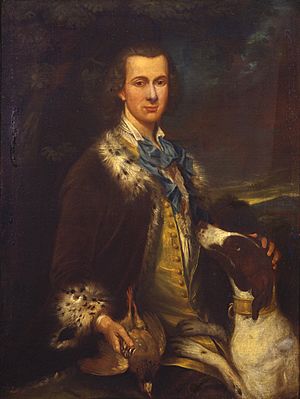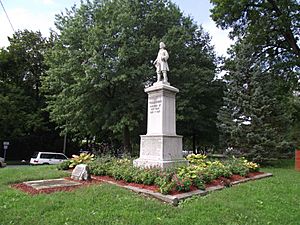Thomas Dongan, 2nd Earl of Limerick facts for kids
Quick facts for kids
The 2nd Earl of Limerick
|
|
|---|---|

Portrait of Dongan from Castleton Manor, Staten Island
|
|
| 5th Colonial Governor of New York | |
| In office August 1683 – 11 August 1688 |
|
| Monarch | Charles II James II & VII |
| Preceded by | Edmund Andros |
| Succeeded by | Edmund Andros (as Governor-General of the Dominion of New England) |
| Personal details | |
| Born | 1634 Castletown Kildrought, Kingdom of Ireland |
| Died | 14 December 1715 (aged 81) London, England |
| Relations | Sir William Talbot, 1st Baronet (grandfather) Sir Robert Talbot, 2nd Baronet (uncle) Peter Talbot (uncle) Richard Talbot, 1st Earl of Tyrconnell |
| Parents | Sir John Dongan, 2nd Baronet Mary Talbot |
| Signature | |
Thomas Dongan, also known as the 2nd Earl of Limerick (born in 1634 – died December 14, 1715), was an important figure in Irish and American history. He served in the Parliament of Ireland and was a military officer. He is best known for being the Governor of the Province of New York from 1683 to 1688.
Dongan made history in New York by setting up the first government where people had representatives. He also created the "Charter of Liberties," which gave many important rights to the people. His strong friendship with the Iroquois Native American tribes helped keep New York safe from French attacks and their allies.
Contents
Early Life and Family Background
Thomas Dongan was born in 1634 in a place called Castletown Kildrought, which is now Celbridge, in County Kildare, Kingdom of Ireland. His family was an old Irish Catholic family. He was the youngest of seven sons.
His father, Sir John Dongan, was a member of the Irish Parliament. His mother, Mary Talbot, came from another important family. After King Charles I was executed, Dongan's family, who supported the king, had to leave Ireland and move to France. It was in France that Thomas Dongan began his military career.
Military Career and Service
While living in France, Thomas Dongan joined an Irish army group. He served under a famous French general named Turenne. Dongan stayed in France even after the king was restored to power in England. By 1674, he had become a colonel in the army.
In 1678, a war between France and the Dutch ended. Dongan was ordered to return to England. There, James, Duke of York, who would later become king, helped Dongan get a high position in the army. Dongan was also given a pension, which is like a regular payment. That same year, he was made Lieutenant-Governor of Tangiers, a city in North Africa that belonged to England. He helped defend the city as part of the Tangier Garrison.
Governor of New York Colony
In September 1682, James, Duke of York, chose Dongan to be the new governor of the Province of New York. Dongan was also made a Vice-admiral in the Navy. He replaced the previous governor, Edmund Andros. Because Dongan had spent a lot of time in the French army, he understood French people and their ways. His time fighting in the Low Countries also taught him some Dutch.
Dongan arrived in Boston on August 10, 1683. He then traveled to Fort James in New York, arriving on August 25. A local minister, Henry Selyns, described Dongan as a "person of knowledge, refinement and modesty."
Restoring Order and Stability
When Dongan became governor, New York was in a difficult situation. The colony was running out of money, and there was a lot of unrest. Dongan worked hard to bring back order and make things stable again.
On October 14, 1683, Dongan called the first-ever meeting of elected representatives in New York's history. This meeting took place at Fort James. The group, called the New York General Assembly, created an important document known as the Charter of Liberties and Privileges.
The Charter of Liberties
The Charter of Liberties was a very important document for the people of New York. It stated that the main power to make laws belonged to the governor, his council, and the people's assembly. It gave the assembly members rights and freedoms, making them equal to the Parliament in England.
The Charter also set up courts for towns, counties, and the whole colony. It bravely announced the right to religious freedom for everyone. It also included other important rights, such as:
- Taxes could only be collected if the people's assembly agreed.
- People had the right to vote.
- Soldiers could not be forced to stay in people's homes without their permission.
Establishing Boundaries and Alliances
Dongan worked to set clear boundary lines for New York. He settled disagreements with Connecticut to the east and with the French Governor of Canada to the north. He also worked out issues with Pennsylvania to the south. These efforts helped define the borders of what is now New York State.
To secure the northern border, Dongan knew it was important to be friends with the Iroquois tribes. He exchanged letters with the French governor about this. Dongan famously said, "certainly our rum doth as little hurt as your brandy and in the opinion of Christians is much more wholesome."
In 1684, Dongan traveled with the Governor of Virginia, Lord Howard of Effingham, to meet with the Iroquois near Albany. They held a meeting and gained the Iroquois' support. The Iroquois Chief called Dongan "corlur," which is an Irish word meaning "advisor."

Albany's City Charter
On July 22, 1686, Governor Dongan gave the city of Albany its own special charter. This charter was very similar to the one given to New York City just three months earlier. It officially made Albany a city, creating a separate government in the middle of the Van Rensselaer Manor.
First Post Office
In 1686, Dongan also set up the first post office in New York. His goal was to improve communication between the different American colonies.
End of Governorship
Later, King James decided to combine the governments of New York, New Jersey, and the New England colonies into one large area called the Dominion of New England. He appointed Edmund Andros, the former Governor-General of New York, to lead this new dominion. Dongan handed over his role as governor to Andros on August 11, 1688.
Dongan then moved to his estate on Staten Island. This estate later became the town of Castleton. Another part of the island, Dongan Hills, was named in his honor. Dongan stayed there until July 1689. During a time of unrest called Leisler's Rebellion, he became worried for his safety and returned to England.
Dongan Patents
Dongan was also responsible for granting land that created several towns across New York State. These included the eastern Long Island communities of East Hampton and Southampton. These grants, known as the Dongan Patents, set up Town Trustees. These Trustees were in charge of managing common land for the good of everyone. The Dongan Patents are still legally binding today.
Later Life and Death
Thomas Dongan spent the last years of his life in London. He passed away on December 14, 1715, at the age of 81. He was buried in Old St. Pancras churchyard in London.
In 1698, his brother, William Dongan, died without children. Because of Thomas Dongan's service to the King as a military officer and governor, he was given his brother's title, Earl of Limerick. He also received some of his brother's lands. In 1709, Lord Limerick sold his large property in Celbridge.
Legacy and Impact
Thomas Dongan is remembered as a very important leader in the history of English colonies. Franklin D. Roosevelt, a former U.S. President, described him as "One of the greatest constructive statesmen ever sent to any English colony."
The assembly that Dongan created passed the "Charter of Liberties and Privileges." This document stated that the people had power and declared important rights like religious freedom, the right to vote, and trial by jury. It also said that taxes could not be collected without the assembly's agreement.
Roosevelt called Dongan's charter "the Magna Charta of American constitutional liberty." Many of its ideas are still part of the United States government today.

